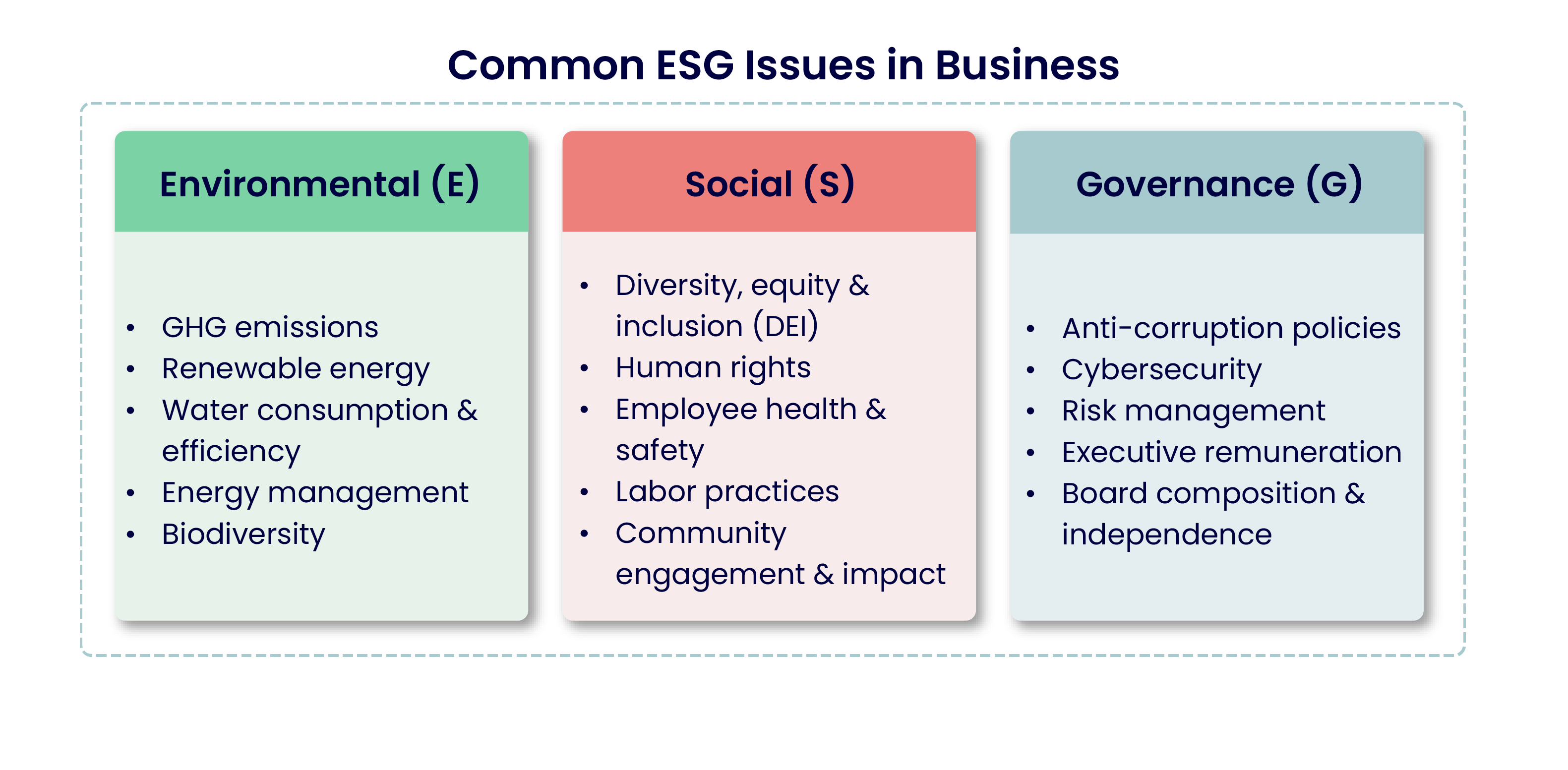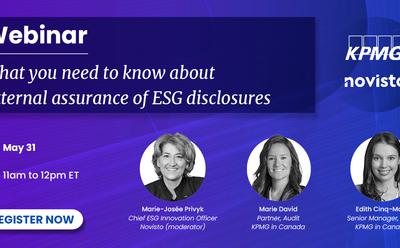
Getting a pulse on what ESG stands for in business is integral to driving positive change and long-term sustainability performance. In Part 2 of this blog series, we’ll examine why ESG is inextricably—and increasingly—linked to business success. Additionally, we’ll explore some common ESG implementation challenges and propose best practices for overcoming them.
What is ESG in business?
ESG issues are core business considerations grouped as environmental (E), social (S), or governance (G) matters (see figure below). They hold the same weight as financial factors. Remember that ESG is distinct from sustainability and that not all ESG issues are relevant to every company; ultimately, it's about what a company does, how it does it, and where it does it.

The three “pillars” of ESG guide ethical business practices and financial and impact materiality profiling. Understanding each is vital to defining what ESG means to your business:
- Environmental (E): Focuses on a company's ecological impact, including resource use, waste management, emissions, and climate action. Embracing sustainability mitigates ecological footprints, reducing a business's negative impact on the planet.
- Social (S): Pertains to a company’s societal influence and risks, encompassing employee welfare, human rights, and community engagement. Prioritizing social responsibility in business builds positive relationships and societal contributions.
- Governance (G): In a business context, strong governance refers to companies acting transparently and honestly, managing risks effectively, and safeguarding the well-being of all stakeholders in their choices. Governance encompasses aspects like corporate leadership, executive compensation, and board structure. Recall that governance is a foundational pillar, supporting overall environmental and social performance.
A changing regulatory and reporting landscape has spurred heightened awareness of the importance of ESG in business. Indeed, there are a plethora of voluntary reporting frameworks and standards to choose from. These help guide companies in measuring and disclosing their ESG performance.

Why should companies care?
As discussed in Part 1 of this two-part series, ESG has gained significant relevance in the business landscape, shaping how companies operate, make decisions, and interact with stakeholders. More organizations across industries are allocating resources to improving their ESG programs, with ninety-five percent of major global companies already disclosing their ESG impacts in 2021.
This trend will only accelerate as mandatory reporting becomes more widespread. For instance, compliance with the IFRS Sustainability Disclosure Standards, projected to become the global standard and to be adopted by most legislatures, is swiftly approaching. In addition, the EU Sustainability Reporting Standards are now legally mandated in the EU through the Corporate Sustainability Reporting Directive (CSRD), starting from January 1, 2024.
That said, ESG performance will increasingly be linked to a company’s health and viability, including financial returns and long-term prospects. Let’s explore some key factors behind ESG’s growing relevance in business.
Risk management and mitigation
Compared to the overarching concept of sustainability, ESG encompasses managing specific ESG issues and their influence on a company’s performance, risk, and long-term outlook, as measured by ESG metrics. Recall that financial materiality pertains to how ESG issues impact a company's risk profile.
Therefore, conducting a financial materiality assessment helps companies identify and subsequently mitigate potential risks, which can encompass:
- Environmental risks: Examining environmental risks entails examining the impact of climate change, natural resource scarcity, and pollution—to name a few—on a business’s operations, financial performance, and so on. In so doing, companies can enhance their resilience to disruptions and regulatory changes.
- Social risks: By evaluating social factors, companies can anticipate and manage reputational risks associated with labor practices, human rights violations, and community relations.
- Governance risks: Fraud, corruption, and unethical behavior are more likely without robust governance mechanisms, including board oversight. Moreover, mitigating these risks is critical to safeguarding the company's reputation and financial stability.
Ultimately, conducting a materiality assessment is a proactive exercise. It allows companies to stay ahead of emerging risks and adapt their strategies accordingly.
Attracting responsible investors
ESG-oriented investment strategies have gained significant traction, with asset managers and institutional investors more likely to consider ESG performance than ever. According to a Thomson Reuters article by Ingo Steinhaeuser, “At the beginning of 2021, 35% of all managed assets worldwide were considered sustainable assets. With an annual growth rate of 15% over the last two years, the market will soon be reaching a point where the term sustainable investing will slowly account for the majority of total global managed assets.” As such, the end of what Steinhaeuser dubs “unsustainable investing” appears imminent, with global ESG assets projected to exceed $53 trillion by 2025.
By aligning with ESG principles, businesses can tap into a growing pool of responsible investors who seek financial returns alongside positive environmental and social impacts. In tangible terms, this means improved access to capital, lower borrowing costs, and enhanced reputational capital.
Enhancing stakeholder relationships
The rise of stakeholder capitalism means that companies are increasingly going beyond their shareholders. This involves creating long-term value for diverse stakeholders, including consumers, employees, suppliers, and the broader community.
Consumers are more likely to support companies that prioritize sustainability and social responsibility, with 80% considering switching to brands more aligned with their values (considering product price and quality are the same). And as the purchasing power of the Gen Z cohort expands, we’re likely to see more values-driven purchasing behavior in the future.
The preference for sustainability also extends beyond consumers, with evidence that employee retention is affected by employer commitment to sustainability. Notably, the Deloitte Consumer Industry Center’s survey of 750 retail employees in the U.S. found that 72% of those employed by retailers with top-tier sustainability initiatives rarely consider seeking new job opportunities; in fact, 79% intend to remain in their current positions over the next couple of years. In contrast, only 40% of employees from retailers with less developed sustainability programs are committed to their present roles.
Driving innovation and competitive advantage
Embracing ESG practices in business can drive innovation and foster a competitive edge. For instance, companies that prioritize sustainability and social responsibility can capture new market opportunities, develop new products, meet evolving consumer demands, and differentiate themselves from competitors (think Patagonia and Unilever).
Integrating ESG into the fabric of the organizational culture can also fuel the development of new products, services, and technologies that address pressing environmental and social challenges. For example, positive ESG ratings are linked to more green innovation outputs, characterized by a rise in green patents.
In summary, the importance of ESG in business goes beyond mere corporate social responsibility: it has transformed into a strategic imperative for companies to remain healthy and competitive. By incorporating environmental, social, and governance factors into their core operations, businesses can mitigate risks, allure ethical investors, strengthen stakeholder engagement, and foster innovation. Embracing ESG in business aligns enterprises with global sustainability objectives and sets them up for success in a world where environmental and social challenges persist.

ESG in business—challenges and best practices
Notwithstanding the critical why’s and what’s of ESG in business, real-world alignment produces unique challenges. Nevertheless, companies can effectively surmount common roadblocks in ESG implementation by adopting suitable approaches and strategies. Let’s explore what these are and how to overcome them.
Challenges in ESG implementation
- Lack of awareness and understanding: Because ESG is a relatively new field, companies may lack critical knowledge of how their particular business or industry can be affected. This is particularly relevant for companies at an early stage of ESG maturity, who may lack awareness of financial and impact materiality and what it means. Unfortunately, knowledge gaps can cause even the best-intentioned of businesses to fall behind their peers, with negative repercussions to reputational capital and overall competitiveness.
- Limited data availability and quality: Businesses frequently find it challenging to collect dependable and comprehensive data to measure and report their ESG performance. Access to consistent and comparable data across different industries and global locations can be restricted, making it arduous to assess ESG factors accurately. Furthermore, since many organizations lack a centralized ‘data hub,’ ensuring the quality and reliability of ESG data becomes an ongoing challenge. Problems may arise from incomplete or inconsistent data, data gaps, data collection or processing errors, and a reliance on self-reported information without independent verification.
- Technology gaps: A lack of software support for ESG data gathering and reporting leads to an overreliance on manual processes, which is costly and time-consuming. Furthermore, disclosure requirements undergo frequent changes. The global landscape currently includes over 600 ESG reporting schemes, which makes navigating the reporting process more arduous. In addition, ESG teams often face numerous information requests and questionnaires, leading to different ESG performance narratives. Failing to invest in comprehensive ESG data management software overwhelms teams and jeopardizes the accuracy and completeness of disclosures. In a progressively regulated environment, not digitizing your ESG processes presents significant risks to your company.
- Limited stakeholder engagement & communication: Managing stakeholder relationships is crucial for driving the success of your ESG programs. Regular engagement allows you to understand stakeholder expectations, gather relevant data, and build trust. Communication ensures timely information sharing for accountability and informed decision-making. Nevertheless, this task becomes complex due to various factors:
- Diverse stakeholder groups: Engaging with investors, employees, customers, communities, NGOs, and regulatory bodies simultaneously poses challenges, as each group has unique interests and information needs
- Varying levels of knowledge: Stakeholders possess varying levels of familiarity and comprehension of ESG issues, reporting frameworks, and terminology. Therefore, effectively communicating complex ESG topics (and extensive data) in a manner that is accessible and meaningful isn’t typically straightforward or intuitive.
- Transparency and trust concerns: Stakeholders increasingly seek transparency and confidence in ESG performance. Yet, ensuring the accuracy, reliability, and consistency of reported data can be challenging, raising concerns about greenwashing or misleading information. The lack of solid data management, verification processes, and clear communication makes building trust a difficult task.
Best practices for adoption
- Conduct a materiality assessment: Companies can’t advance their ESG programs without first identifying which ESG issues matter most. A materiality assessment involves identifying which ESG issues are most critical to your business (i.e., operations, financial performance, risk profile, etc.) and your stakeholders. These findings can then be captured in a materiality matrix, which plots critical business factors and stakeholder priorities along the X and Y axes, respectively.
Using a materiality matrix can provide companies with a powerful visual presentation of the most critical topics, serving as the fundamental building block of their corporate ESG programs. In turn, this can inform the type of ESG metrics that a company will choose to focus on, their business strategy, risk management planning, etc.
- Setting ESG goals and metrics: Establishing clear and meaningful ESG goals is crucial for monitoring progress and promoting continuous improvement. These goals must be SMART (specific, measurable, attainable, relevant, and time-bound), reflect your company's purpose and values, and align with stakeholder expectations. Establishing specific ESG metrics can help you gauge your ESG progress and holistic performance more accurately.
- Adopting ESG data management tools: ESG data management software streamlines the collection, analysis, and reporting of ESG-related information. When undertaken manually, these processes are intricate, time-intensive, and prone to error. ESG or sustainability software automates and oversees these tasks, significantly reducing the time required for producing ESG reports or completing questionnaires. An ESG platform also efficiently handles extensive datasets; while the specific data categories might differ, an advantage of employing ESG data management software lies in its adaptability to monitor diverse ESG metrics tailored to your business priorities and requirements.
- Incorporation into business strategy: According to the Harvard Law School Forum on Corporate Governance, an ESG strategy cannot be divorced from company strategy and overarching objectives. Here, board and senior management participation are required to get alignment on what ESG means to the business. Moreover, the findings from the materiality assessment need to shape the business strategy directly, as it will set the tone for the entire ESG program.
- Leadership commitment and board engagement: Effective adoption of ESG practices begins with firm leadership commitment and active board oversight. The latter plays a central role in the success of corporate ESG programs by ensuring effective alignment with long-term objectives and fostering accountability. Furthermore, leaders need to advocate for integrating ESG into the fabric of the organization’s culture, including its vision and core values.
- Collaborate & communicate with stakeholders: Involving stakeholders is vital for successful ESG implementation. Seek input from employees, customers, investors, and communities to grasp their expectations. In turn, incorporating their feedback can go a long way in enhancing the relevance of your ESG programs. To keep stakeholders informed and engaged, consider communicating ESG performance through various channels like annual reports, sustainability reports, web pages, and social media. To this end, leverage ESG reporting tools to facilitate more effective communication, instilling data confidence and performance clarity.
- Transparent reporting and disclosures: Transparent reporting and disclosure of ESG performance is vital to building trust and credibility. Companies can adopt reporting standards and frameworks like the GRI or TCFD to ensure comprehensive and standardized reporting. Transparent communication of goals, progress, and challenges helps stakeholders understand the company's commitment to ESG and identify new growth opportunities.
- Continuous improvement and learning: Because ESG is an evolving field, companies should embrace a mindset of continuous improvement and learning. Regularly reviewing and evaluating ESG practices allows internal stakeholders to identify areas for enhancement and adjust their strategies accordingly. Engaging in industry networks, participating in ESG conferences and fora, and staying informed about emerging trends and best practices are essential for feeling connected to a larger community.
In summary, implementation barriers can be overcome through various actions, including integrating ESG into business strategy, having strong board oversight, and effectively communicating ESG performance. While success can’t be achieved overnight, identifying roadblocks and taking appropriate action will help get you there faster.

Looking ahead
Embracing ESG in business is not only the right thing to do—it’s essential for long-term success. Integrating environmental, social, and governance considerations into your core strategy and operations allows your business to create value for diverse stakeholders while contributing to a more sustainable and inclusive future.
However, this is easier said than done. Especially since the current landscape requires robust, data-driven ESG decision-making, spurred by investor demand for greater accuracy and transparency. Consequently, technology has emerged as a key player, imperative to helping businesses develop a unified sustainability narrative and seize internal momentum.
Novisto’s data management platform is designed to help organizations overcome the inherent challenges of ESG reporting. Leveraging the power of AI to automate and streamline ESG data collection, analysis, and reporting, Novisto can help you:
- Get a handle on emerging risks and opportunities
- Create resonant narratives for your stakeholders
- Enhance decision-making across all areas of your business
- Steer clear of low-quality ESG data
Take your sustainability journey to the next level. Book your demo today.
